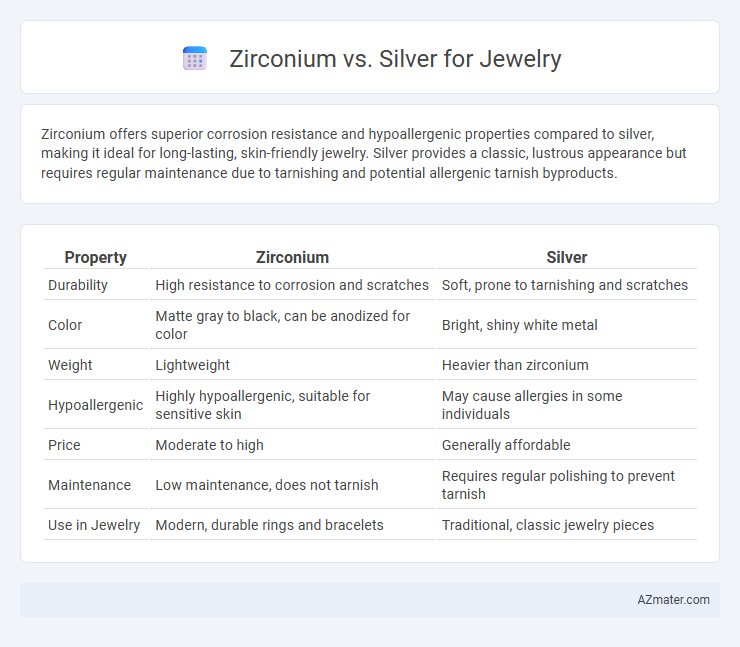Zirconium offers superior corrosion resistance and hypoallergenic properties compared to silver, making it ideal for long-lasting, skin-friendly jewelry. Silver provides a classic, lustrous appearance but requires regular maintenance due to tarnishing and potential allergenic tarnish byproducts.
Table of Comparison
| Property | Zirconium | Silver |
|---|---|---|
| Durability | High resistance to corrosion and scratches | Soft, prone to tarnishing and scratches |
| Color | Matte gray to black, can be anodized for color | Bright, shiny white metal |
| Weight | Lightweight | Heavier than zirconium |
| Hypoallergenic | Highly hypoallergenic, suitable for sensitive skin | May cause allergies in some individuals |
| Price | Moderate to high | Generally affordable |
| Maintenance | Low maintenance, does not tarnish | Requires regular polishing to prevent tarnish |
| Use in Jewelry | Modern, durable rings and bracelets | Traditional, classic jewelry pieces |
Introduction to Zirconium and Silver Jewelry
Zirconium and silver are popular metals in jewelry making due to their unique properties and appeal. Zirconium features exceptional corrosion resistance, hypoallergenic qualities, and a sleek, dark gray finish that distinguishes it from traditional metals. Silver offers a classic bright luster, high malleability, and affordability, making it a timeless choice for rings, necklaces, and bracelets.
Physical Properties: Hardness and Durability
Zirconium exhibits exceptional hardness with a Mohs rating around 6, surpassing silver's softer 2.5 to 3, making zirconium more resistant to scratches and everyday wear in jewelry. Its superior durability and corrosion resistance ensure longer-lasting shine without tarnishing, unlike silver, which is prone to oxidation and requires frequent polishing. These physical properties position zirconium as a robust, low-maintenance alternative to silver for high-durability jewelry applications.
Appearance and Aesthetic Differences
Zirconium jewelry exhibits a sleek, modern appearance with its dark, matte finish that contrasts sharply with silver's bright, reflective shine and classic luster. Silver offers a timeless elegance with its cool white-metal hue that complements a wide range of styles, while zirconium's unique gunmetal gray tone appeals to contemporary and edgy aesthetics. The distinct color and texture differences make zirconium ideal for those seeking bold, unconventional jewelry, whereas silver remains popular for its versatility and traditional beauty.
Hypoallergenic Qualities: Skin Sensitivity
Zirconium is highly regarded in jewelry for its exceptional hypoallergenic qualities, making it an ideal choice for individuals with sensitive skin or metal allergies. Unlike silver, which can cause irritation or allergic reactions due to its nickel content or tarnishing properties, zirconium remains inert and does not react with skin oils or moisture. Its biocompatibility ensures prolonged wear without skin redness, itching, or discomfort, making zirconium a superior option for hypoallergenic jewelry.
Tarnish Resistance and Maintenance
Zirconium offers superior tarnish resistance compared to silver, making it an ideal choice for jewelry that maintains its appearance over time without frequent polishing. Silver requires regular cleaning and protection from exposure to air and moisture to prevent oxidation and darkening. The low maintenance nature of zirconium jewelry appeals to wearers seeking durable pieces with long-lasting luster.
Weight and Comfort for Daily Wear
Zirconium jewelry weighs significantly less than silver, making it more comfortable for daily wear, especially in larger pieces like rings and bracelets. Its lighter weight reduces strain on fingers and wrists, enhancing all-day comfort. Silver's slightly heavier density can feel more substantial but may cause discomfort during prolonged use.
Cost Comparison: Affordability and Value
Zirconium jewelry typically offers greater affordability than silver, with lower material and manufacturing costs contributing to its budget-friendly price. Silver's market price fluctuates more due to its status as a precious metal, often making silver pieces more expensive per gram than zirconium counterparts. Despite the higher cost, silver maintains strong resale value and traditional appeal, while zirconium provides a cost-effective alternative with durable, hypoallergenic properties.
Popular Uses and Jewelry Styles
Zirconium is popular in modern jewelry for its durability, hypoallergenic properties, and sleek, dark finish, often used in men's rings and contemporary designs. Silver remains a classic choice, prized for its bright luster and affordability, commonly featured in traditional, vintage, and artisanal jewelry styles. Both metals offer versatility, with zirconium favored in minimalist and industrial aesthetics, while silver thrives in ornate and delicate craftsmanship.
Longevity and Wear Over Time
Zirconium exhibits exceptional durability and resistance to corrosion, ensuring that it retains its appearance and structural integrity over many years without significant wear, making it ideal for daily-wear jewelry. Silver, while highly valued for its classic luster, is prone to tarnishing and scratching over time, necessitating regular maintenance to preserve its shine. The superior hardness and oxidation resistance of zirconium contribute to longer-lasting jewelry that maintains its aesthetic appeal with minimal care compared to silver.
Choosing Between Zirconium and Silver: Which Is Better?
Zirconium offers exceptional durability and hypoallergenic properties, making it an ideal choice for long-lasting and skin-friendly jewelry, while silver is prized for its classic luster and affordability but requires regular polishing to prevent tarnish. Zirconium's resistance to corrosion and scratches ensures jewelry maintains its appearance over time, contrasting with silver's susceptibility to oxidation and maintenance needs. Selecting between zirconium and silver depends on prioritizing either enduring strength and low maintenance or traditional elegance and budget-conscious options.

Infographic: Zirconium vs Silver for Jewelry
 azmater.com
azmater.com